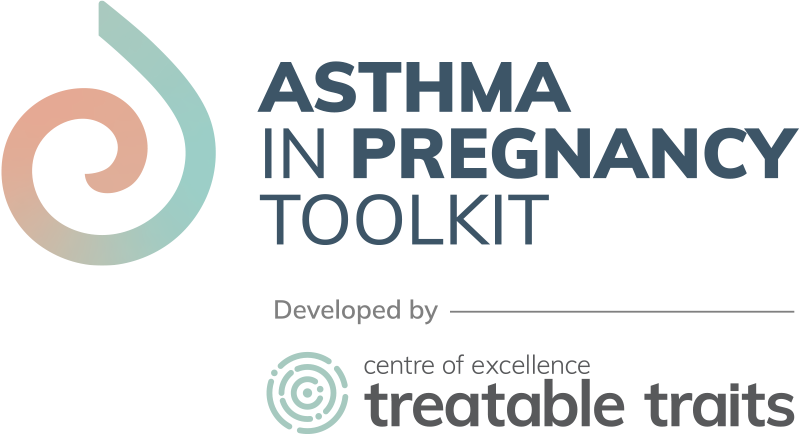Key message
- Regular anti-asthmatic therapy with inhaled corticosteroids, β2-agonists and muscarinic antagonists is safe and should be routinely used to secure asthma control to ensure less risk of adverse outcomes for the mother and the fetus.
Mechanism
Corticosteroids
Steroid hormones can be grouped into two classes: corticosteroids (typically made in the adrenal cortex, hence cortico-) and sex steroids (typically made in the gonads or placenta). Within those two classes are five types according to the receptors to which they bind: glucocorticoids which are important in asthma, and four others. Glucocorticoid hormones help control inflammation and immune functions. The term steroid describes both hormones produced by the body and artificially produced medications that duplicate the actions of naturally occurring steroids. These drugs can be used as either inhaled corticosteroids (ICS), intranasal corticosteroids (INCS) and systemic corticosteroids, often taken orally (oral corticosteroids, OCS).
β-agonists (SABA, LABA)
Activation of β adrenergic receptors leads to relaxation of smooth muscle in the airway, which leads to dilation and opening of the airways. β adrenergic receptors are coupled to a stimulatory G protein of adenylyl cyclase. This enzyme produces the second messenger cyclic adenosine monophosphate (cAMP). β adrenergic agonists are a class of sympathomimetic agents which act upon the β adrenoceptors. They can be short acting (SABA) or long acting (LABA).
Muscarinic antagonists (LAMA, SAMA)
A muscarinic receptor antagonist (MRA) is a type of anticholinergic agent that blocks the activity of the muscarinic acetylcholine receptor. The muscarinic receptor is a protein involved in the transmission of signals through certain parts of the nervous system, and MRAs work to prevent this transmission from occurring. Notably, MRAs reduce the activation of the parasympathetic nervous system. Muscarinic antagonists counter this parasympathetic “rest-and-digest” response, to hinder bronchoconstriction.
The muscarinic receptor antagonists can be used as both short-acting and long-acting versions – SAMA or LAMA respectively.
Indication
Mono-therapy with short-acting β2-agonist (SABA) is no longer recommended for asthma (GINA). Recent trials in mild asthma (Zygoma study) have shown that ‘as needed’ use of a fixed combination of long-acting β2-agonist with fast onset of action and low-dose ICS, e.g. formoterol and budesonide, can be recommended as step one asthma therapy (Beasley et al. 2019). If required to achieve asthma control, it can be stepped up to be used as both maintenance and reliever therapy (SMART). SABA can be used as reliever therapy but always together with maintenance ICS, which have shown to be effective in asthma management resulting in lower overall use of steroids, and fewer exacerbations (Beasley et al. 2019, Couillard et al. 2021). Studies are needed to evaluate the use of this approach in pregnancy.
The National Asthma Council Australia has developed a useful Asthma & COPD Medications chart, with images of inhaler devices and available dosages. Download pdf here.
Evidence for safety relating to fecundity, pregnancy and breastfeeding
Fetal malformation after use of inhaled SABA is unlikely to happen, however systemic administration may cause adverse cardiovascular and metabolic effects. Systemic SABA during delivery may have a tocolytic effect. LABA should never be used alone, but if needed for the gain of asthma control, should be used in combination with an inhaled corticosteroid. There is limited human data available on LABA and effects on the fetus, however they also appear to have low, if any, risk.
At usual dose levels, ICS have not been associated with increased risk of malformations, pre-term delivery or low birthweight. Higher doses may lead to some malformations, but this could also be due to a higher frequency of exacerbations.
Salmeterol, which has the longest safety record, can be used in fixed combination with ICS (ICS/LABA) as maintenance therapy together with SABA as needed. Other LABAs in fixed combination with ICS can be considered, not at least in case of adherence issues.
Resources
- TGA Prescribing medicines in Pregnancy Database (Australia): includes definitions of Australian medicine categories and a medicines Database search
- Table of common asthma medication actions and their safety profiles (adapted from the ERS/TSANZ Task Force Statement on the management of reproduction and pregnancy in women with airways diseases)
- MotherSafe (Australia) provides detailed guidance on medication safety in pregnancy and are available to both patients and clinicians alike. Visit MotherSafe contact details page here.

Content has been reproduced with permission from the Centre of Excellence in Severe Asthma, originally developed as part of the Centre of Research Excellence in Severe Asthma (https://toolkit.severeasthma.org.au).
